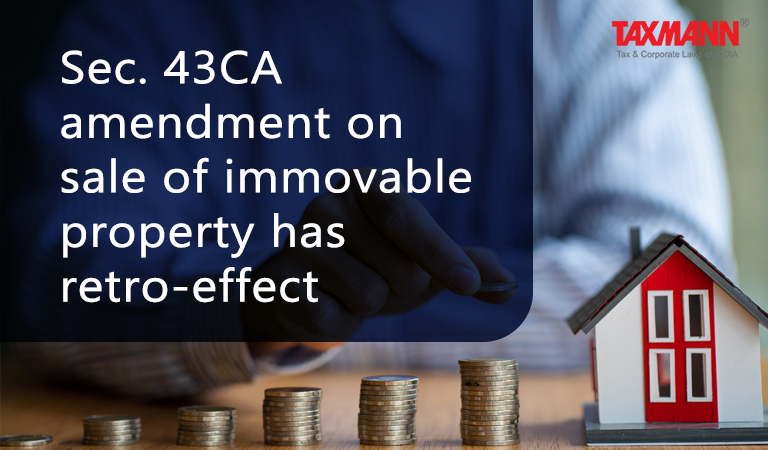Sec. 43CA amendment on sale of immovable property has retro-effect
- Blog|News|Income Tax|
- 2 Min Read
- By Taxmann
- |
- Last Updated on 23 November, 2022

Case Details: Sai Bhargavanath Infra v. ACIT - [2022] 144 taxmann.com 168 (Pune-Trib.)
Judiciary and Counsel Details
-
- R.S. Syal, Vice President & Partha Sarathi Chaudhury, Judicial Member
- Suhas Bora for the Appellant.
- Arvind Desai for the Respondent.
Facts of the Case
Assessee-company was a builder and developer. During the assessment, the Assessing Officer (AO) made additions under section 43CA on account of the difference between the sale value of flats sold and the stamp duty value of the same.
The assessee opposed the additions by contending that the difference between the sale value of the flats sold and the stamp duty value was less than 10%. Therefore, no such addition wasn’t warranted. However, the AO rejected the assessee’s contention and passed the assessment order.
On appeal, the CIT(A) upheld the order AO. Aggrieved-assessee filed the instant appeal before the Tribunal.
ITAT Held
The Tribunal held that section 43CA provides that if consideration from the transfer of asset (land or building) is lesser than its stamp duty value then the difference will be taxed as deemed income. However, if the difference between such value is within 10% margin, then there cannot be any addition.
This 10% margin had been provided by the Finance Act, 2020 w.e.f., 01-4-2021, and before that the margin was 5%. The instant case was related to A.Y. 2015-16 which is prior to the date when the amendment took place and such 10% margin was inserted.
Now, the question arises whether this amendment effective from 1-4-2021 can even apply to prior assessment years as well.
Relying upon the spirit of the Supreme Court decision in the case of Vatika Township (P.) Ltd. [2014] 49 taxmann.com 249, the Tribunal held that if a fresh benefit is provided by the Parliament in an existing provision, then such an amendment should be given retrospective effect. The statute must spell out clearly if any tax liability has to be fastened with the assessee tax-payer with retrospective effect. However, if the provision is beneficial for the assessee such a beneficial provision can be applied in a retrospective manner.
In the given case, the legislature intended to provide relief to the assessee if the difference is less than 10% which has been brought into effect from 1-04-2021. This beneficial provision will apply with retrospective effect.
List of Cases Reviewed
-
- CIT v. Vatika Township (P.) Ltd. [2014] 49 taxmann.com 249/227 Taxman 121/367 ITR 466 (para 4) followed.
List of Cases Referred to
-
- V.K Developers v. ACIT [IT Appeal No. 923 (Pune) of 2019, order dated 4-8-2022] (para 3)
- Sai Bhargavnath v. Dy. CIT [IT Appeal No. 2417 (Pune) of 2017, dated 8-9-2020] (para 3)
- Maria Fernandes Cheryl v. ITO (International Taxation) [2021] 123 taxmann.com 252/187 ITD 738 (Mum) (para 4)
- CIT v. Vatika Township (P.) Ltd. [2014] 49 taxmann.com 249/227 Taxman 121/367 ITR 466 (SC) (para 4)
- CIT v. Suresh N. Gupta [2008] 166 Taxman 313/297 ITR 322 (SC) (para 4)
- CIT v. Rajiv Bhatara [2009] 178 Taxman 285/310 ITR 105 (SC) (para 4)
- Dinar Umeshkumar More v. ITO [IT Appeal No. 1503 (Pune) of 2015, dated 25-1-2019] (para 5-6).
Disclaimer: The content/information published on the website is only for general information of the user and shall not be construed as legal advice. While the Taxmann has exercised reasonable efforts to ensure the veracity of information/content published, Taxmann shall be under no liability in any manner whatsoever for incorrect information, if any.

Taxmann Publications has a dedicated in-house Research & Editorial Team. This team consists of a team of Chartered Accountants, Company Secretaries, and Lawyers. This team works under the guidance and supervision of editor-in-chief Mr Rakesh Bhargava.
The Research and Editorial Team is responsible for developing reliable and accurate content for the readers. The team follows the six-sigma approach to achieve the benchmark of zero error in its publications and research platforms. The team ensures that the following publication guidelines are thoroughly followed while developing the content:
- The statutory material is obtained only from the authorized and reliable sources
- All the latest developments in the judicial and legislative fields are covered
- Prepare the analytical write-ups on current, controversial, and important issues to help the readers to understand the concept and its implications
- Every content published by Taxmann is complete, accurate and lucid
- All evidence-based statements are supported with proper reference to Section, Circular No., Notification No. or citations
- The golden rules of grammar, style and consistency are thoroughly followed
- Font and size that’s easy to read and remain consistent across all imprint and digital publications are applied




